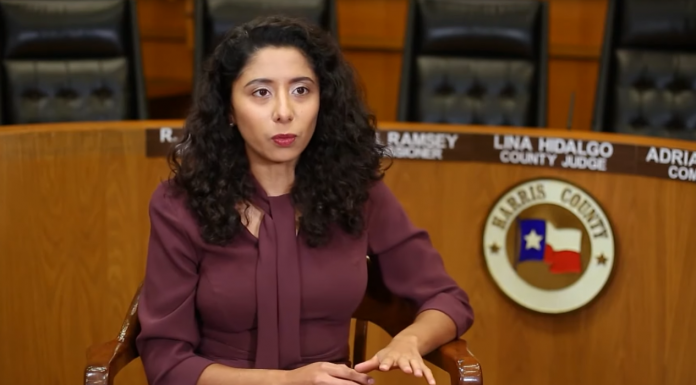(Three Harris County voters and two Republican County Commissioners have sued far-left Harris County Judge Lina Hidalgo and Harris County for a redistricting plan proposed by a Democrat commissioner, alleging it unconstitutionally disenfranchises more than a million voters in next year’s county elections.
Harris County is the largest county in Texas with 4.7 million residents, according to 2020 Census data. Roughly half, or 2.48 million residents, are registered to vote, according to the Texas Secretary of State’s office, with 1.63 million having voted in the 2020 General Election.
The lawsuit filed in U.S. District Court in Harris County asks the court to issue a temporary restraining order and/or temporary or permanent injunction against the judge and county from implementing the redistricting plan.
The Commissioner’s Court comprises four commissioners representing four districts, and the county judge. Two commissioners are Democrats (Precincts 1 and 2), two are Republicans (Precinct 3 and 4) and the judge is a Democrat.
The redistricting map proposed by Democratic Commissioner Rodney Ellis, known as the “Ellis Plan 3,” would redraw the lines in such a way to ensure that Democrats would hold a supermajority on the court because it would likely eliminate one of the Republican districts.
Harris County Republicans argue the Democrats’ goal is to eliminate a Republican from the court to ensure a Democratic supermajority.
One way to do this is to take advantage of a stipulation in the Texas Constitution that states that elections for county commissioners, who serve four-year terms, must be staggered every two years.
Ellis’ plan redraws the district lines so much so that it moves 1.1 million voters from even-numbered to odd-numbered voting precincts—thereby eliminating their ability to vote in at least the next election.
For example, under the state constitution’s staggered election process, residents of Precincts 2 and 4 will vote in 2022; residents in Precincts 1 and 3 will vote for their commissioners in 2024. Voters in Precincts 2 and 4 would vote again in 2026, and voters in Precincts 1 and 3 in 2028.
Under Ellis’ plan, his Precinct 1 would remain largely unchanged.
But Cagle’s Precinct 4 would absorb the northeastern portion of the existing Precinct 2, and the northwestern portion of the existing Precinct 3.
Precinct 4 would include Katy in west Harris County, and Baytown in East Harris County, which are at least an hour apart without traffic.
Some of the Precinct 4 residents would also be moved to an odd-numbered precinct, and not be able to vote until 2024. If the district weren’t redrawn, they’d be voting in 2022.
And the newly chopped up Precinct 4, historically a Republican stronghold, would be transformed enough to become a Democratic precinct. Then, the 3–2 Democrat-Republican court would become a 4–1 Democratic-controlled court.
“The Ellis map moves over a million Harris County voters who did not get to vote for commissioner last year to a new precinct where they won’t get to vote for commissioner next year, either,” Alan Vera, a conservative leader within the Harris County Republican Party and plaintiff in the lawsuit, said in a Houston Public Media report.
“Those voters will have gone six years without the right to vote for a county commissioner, when they’re entitled to vote for commissioner every four years,” Vera said.
“Democrats on Commissioners Court were so intent on padding their 3–2 majority that they callously and intentionally trampled on our clients’ sacred right—the right to elect their government officials and to participate in the electoral process,” the plaintiffs’ attorney Andy Taylor said in a statement when announcing the lawsuit.
Officials are required to set district lines every 10 years according to new census data, to ensure “one person, one vote” proportionality. County precincts are required to be drawn with no more than a 10% population deviation.
While courts have historically upheld partisan redistricting plans, Taylor argues the districts can’t be redrawn “in a manner that violates the constitutional rights of voters in those precincts.”
He and the plaintiffs’ other attorneys prepared an alternate redistricting map that they argue is constitutionally valid, and only moves a fraction of the number of voters compared to those moved by Ellis’ plan.
Judge Hidalgo maintains the plan is legal, as does Harris County Attorney Christian Menefee. He says the county “ran a transparent and thorough redistricting process” and the map the court adopted “complies with Texas law.”
Ellis has argued that Harris County was previously gerrymandered by Republicans, and that his map corrects that.
“Our plan seeks to keep communities of interest together and bring together areas that have been split apart for years,” Ellis said.
“For too long this county has been intentionally divided by precinct boundaries that deny people the opportunity to elect representation that accurately reflects the views of the majority of our communities,” he continued. “The boundaries proposed cease that continued suppression, and allows the voices and views of the people to be reflected by those who represent them.”
Republicans argue the opposite.
If the court grants their request for injunction and directs the commissioners court to go back to the drawing board, and if the commissioner’s court fails to adopt an acceptable redistricting plan in time for the March primaries, the county could use the current map or the plaintiffs’ map for the 2022 election cycle.

